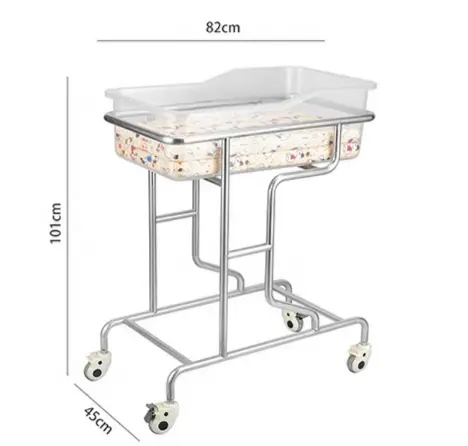Comparing Fully Automatic and Manual Hospital Beds: What You Need to Know
Hospital beds are the unsung heroes of healthcare, providing comfort and support to patients of all ages and conditions. They play a crucial role in the recovery process, ensuring that patients are as comfortable as possible and that caregivers can provide the best care.
Understanding the differences between fully automatic and manual hospital beds is crucial for healthcare providers, patients, and caregivers. These beds offer distinct advantages and are suitable for different scenarios, making the choice a critical factor in patient care.
Understanding Fully Automatic Hospital Beds: The Advanced Care Partner
Fully automatic hospital beds are the epitome of modern healthcare technology. These beds automate tedious tasks, reducing the physical effort required from patients, therapists, and caregivers. Imagine a bed that not only adjusts for your needs but also ensures safety and comfort, all with a press of a button.
- Sensors and Motion Detection: These beds are equipped with sensors that detect movements, ensuring stability and preventing falls. It's like having a safety guard that watches over you.
- Ease of Use: With intuitive controls, these beds are user-friendly. Whether you're bedridden or recovering, fully automatic beds provide the assistance you need with a touch of technology.
- Enhanced Safety: By automatically adjusting and monitoring your position, fully automatic beds minimize the risk of falls, crucial for elderly patients or those recovering from surgery.
- Integration with Therapy: These beds can work with therapy equipment, offering personalized care tailored to your recovery needs.
Fully automatic beds are your partner in recovery, offering advanced technology to enhance comfort and safety.

Manual Hospital Beds: Flexibility and Cost-Effectiveness
Manual hospital beds are the hands-on companions of healthcare, offering a straightforward solution that many find reliable and cost-effective. These beds are perfect for settings where simplicity meets functionality.
- Manual Adjustment: Offering precise control, manual beds allow patients to adjust their position as needed, providing flexibility and comfort.
- Simplicity and Cost-Effectiveness: These beds are a budget-friendly option, making them a practical choice for various healthcare settings.
- Adaptability: Manual beds are highly adaptable, often used in therapy and rehabilitation where manual control is essential.
While manual beds may lack the advanced technology of fully automatic beds, they offer a cost-effective and reliable solution for those who prefer hands-on control.
Comparing the Two: Whats Best for You?
Choosing between fully automatic and manual beds depends on your specific needs and the care environment you're in.
- Patients with Limited Mobility: Fully automatic beds provide the necessary adjustments and safety features, reducing falls and enhancing comfort.
- Depth of Recovery: These beds excel during early recovery, offering the support needed to facilitate healing.
- Integration with Therapy: Their advanced features make them ideal for therapy, ensuring personalized care tailored to each patients needs.
Manual beds, on the other hand, offer a hands-on approach, ideal for therapy and rehabilitation centers where manual adjustments are crucial.
Suitability for Different Patient Needs
Each type of bed has its strengths, making them suitable for various scenarios:
- Manual Beds: Ideal for early therapy and situations requiring precise control.
- Fully Automatic Beds: Best for patients needing advanced technology and frequent adjustments.
For example, a manual bed excels in therapy centers where therapists guide patients, while fully automatic beds are perfect for post-surgery recovery, offering the safety and comfort patients need.
Technological Advancements and Future Trends
The future of hospital beds looks promising, with emerging technologies like AI-driven automation and smart sensors enhancing functionality. Imagine beds that adapt to your needs, offering real-time care and improving patient outcomes.
These advancements promise to make care more efficient and personalized, setting a new standard in healthcare.
Envisioning a Seamless Transition
The future of healthcare beds lies in their ability to adapt to diverse patient needs. A combination of manual and fully automatic beds could create a personalized approach, ensuring each patient receives the care they need.
For instance, a manual bed could offer the hands-on control patients require, while fully automatic features provide the advanced assistance needed for frequent adjustments.
Choosing the Right Bed for a Healthier You
Hospital beds are a vital part of care, and choosing the right type can significantly impact patient outcomes and comfort. Fully automatic beds offer advanced technology for those who need it, while manual beds provide flexibility and cost-effectiveness.
As we move forward, the integration of technology with patient care will continue to evolve, offering new opportunities for care improvement. The next step is to make an informed decision that aligns with your patients needs, ensuring a healthy and comfortable journey.
Final Summary: A Healthier Perspective on Care
In choosing between fully automatic and manual hospital beds, consider the unique needs of your patients and the capabilities of your healthcare facility. Fully automatic beds provide advanced technology for those requiring it, while manual beds offer simplicity and adaptability.
By making an informed choice, you can enhance the quality of care, improve patient outcomes, and create a more comfortable environment for treatment. The future of healthcare beds looks bright, with technology opening new avenues for personalized care.
